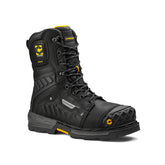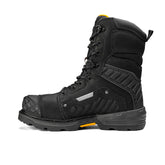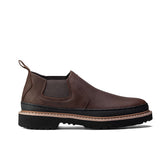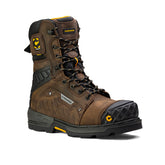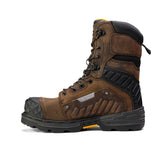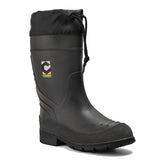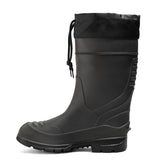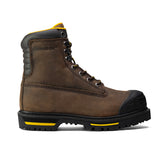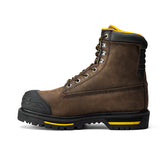Leather vs. Synthetic Work Boots
When it comes to choosing work boots, durability is king. Nobody wants to invest in a pair of boots only to see them fall apart after a few months on the job.
Leather Boots vs Synthetic Boots
But the big question remains: should you go for classic leather or stick with modern synthetic options? Both have their loyal fans, but which truly holds up in the long run? Let’s break it down.
Leather Work Boots: A Classic for a Reason
Leather work boots have been a staple for decades, and it’s easy to see why. The material itself—especially full-grain leather—is naturally tough. Think of it like nature’s armor: it’s flexible, breathable, and incredibly strong. With the right care, leather can outlast just about any other material out there.
But there’s a catch. Leather doesn’t handle water as gracefully as you might hope. Sure, a bit of waterproofing spray can help, but without regular maintenance, your leather boots might start looking like a soggy mess after a rainy day on the job site.
On the flip side, properly conditioned leather softens and molds to your feet over time, offering unmatched comfort and support—a trait synthetic boots often can’t match.
Then there’s the repairability factor. Leather boots can be resoled and repaired, giving them a second (or third) life. That’s something synthetic boots can rarely compete with. If longevity is your main goal, leather’s ability to age gracefully makes it a top contender.
Synthetic Work Boots: The Modern Contender
Synthetic boots have come a long way. Made from materials like nylon, polyester, and advanced composites, they’re designed to tackle challenges that traditional leather might struggle with. For starters, synthetic boots are often lighter—a blessing when you’re putting in long hours. Nobody wants to feel like they’re dragging around concrete blocks at the end of the day.
They’re also champs in wet conditions. Many synthetic boots come with built-in waterproofing, and they dry faster than leather when soaked. Plus, they’re resistant to chemicals and abrasions, making them a solid choice for certain industries.
But here’s the rub: while synthetics are tough, they don’t age the same way leather does. Instead of wearing in, they tend to wear out. Once they’re done, they’re done—there’s no bringing them back from the brink.
Durability-wise, synthetics might last a good while, but they’re not built for the long haul in the same way leather boots are. If your job involves heavy-duty tasks, you’ll likely find yourself replacing synthetic boots more frequently.
Are Leather or Synthetic Boots More Durable?
Let’s get down to brass tacks. When it comes to sheer lifespan:
Leather boots are like a trusty old truck. They’re rugged, dependable, and can handle a beating—as long as you’re willing to give them a bit of TLC now and then. Clean them, condition them, and they’ll stick with you for years.
Synthetic boots, on the other hand, are more like a shiny sports car. They’re flashy, high-performing, and great for specific conditions—but don’t expect them to last forever.
Of course, “lasting longer” doesn’t always mean “better.” The right choice depends on your job, environment, and personal preferences.
Comfort and Performance: Leather vs. Synthetic
Let’s talk about comfort. Leather boots have a unique ability to mold to your feet over time. The break-in period can be rough (think blisters and sore spots), but once they’re broken in, they’re yours—custom-fit to your feet and the way you move.
Synthetic boots skip the break-in drama. Straight out of the box, they’re often more comfortable. Lightweight and flexible, they’re ideal for jobs where mobility is key. But while they might feel great at first, they don’t adapt to your feet the way leather does over time. Over months of wear, you might find synthetic boots losing their initial charm.
Maintenance Matters
Here’s the deal: if you’re not into maintenance, leather boots might not be for you. They need regular cleaning, conditioning, and waterproofing. Think of it like owning a classic car—the extra care pays off in the long run. Neglect them, though, and you’ll be kicking yourself when they crack or lose their shine.
Synthetic boots, by comparison, are low-maintenance. A quick wipe-down with a damp cloth, and you’re good to go. No conditioning, no special sprays—just simple, straightforward care. But while this convenience is appealing, it’s worth remembering that synthetics don’t bounce back the way leather does when they start showing signs of wear.
Cost vs. Longevity: What’s the Real Value?
Leather boots typically come with a higher price tag. But that’s because you’re investing in something that can last for years if treated right. Synthetic boots are often cheaper upfront—a tempting option if you’re on a budget. Just remember: you might end up spending more in the long run if you’re replacing them every year or two.
Final Verdict
So, which lasts longer? The answer—like so many things—depends. Leather boots win the durability crown for their ability to weather years of hard use with proper care. But synthetic boots have their place, especially for jobs that demand lightweight, water-resistant options.
Ultimately, the right choice is the one that fits your needs, your job, and your lifestyle. After all, your work boots aren’t just footwear—they’re tools. And the best tools are the ones that work as hard as you do.

